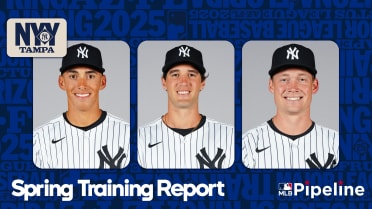Jays eager to sharpen analysis with Hawk-Eye

TORONTO -- If all goes according to plan, it won’t be long before the Blue Jays will be able to venture into the unknown.
As Toronto has continued to make strides to bolster its roster ahead of the upcoming season, an upgrade in technology across the Major Leagues has brought some added excitement to Rogers Centre.
In August, the installation of Hawk-Eye ball tracking began, a move marking the beginning of the transition from Trackman to the optical technology of the new system, one that looks to offer information on a larger scale and with more depth and options for usage than ever before. At first glance, some of the information provided from teams to players will just be a newer version of the same old ideas, but the excitement for the Blue Jays lies in the uncharted territory.
“Where it gets cooler for us is where we start expanding beyond that with some of the newer stuff that will be available,” assistant general manager Joe Sheehan said. “It’s the unknown. I don’t know what we can do with that yet, because we don’t have it -- we need to see what we have first as opposed to the stuff that is similar in both systems.”
One highly anticipated improvement in technology is Hawk-Eye’s ability to offer skeletal imaging and use more data points than were previously available, increasing the level of accuracy in the wealth of information that will become available. Hawk-Eye’s Synchronised Multi-Angle Replay Technology (SMART) uses video to paint a more in-depth picture than teams previously had access to.
“You’re seeing the seams [on the ball] and you’re counting the seams and you’re counting the rotation -- that’s a more accurate way to get that information than the radar system, so you’re able to do more with it,” Sheehan said. “You’ve got a more accurate representation of the flight of the ball, the spin off of the bat.
“Some of that stuff right now is more estimated than directly measured, so you’re able to see that now. A hit ball has spin on it, and that’s important. You can know the exit speed and the different launch angle and the spray angle, but the spin plays a factor in it. If it’s spinning this way, it’s going to do something, and if it’s back spun, it’s going to do something else, and if it’s top spun -- we’re going to have that now, so that’s exciting.”
In order to understand the capabilities of the new technology and the transition in ballparks from Trackman -- a system that has been in some stadiums for more than a decade, all stadiums since 2015, and at Rogers Centre for the last eight years -- Hawk-Eye made presentations to team executives and front office members at the annual GM meetings and owners’ meetings in Arizona and Texas in November as well as at Winter Meetings in San Diego.
For Mark Shapiro, the president and CEO of the Blue Jays, and his “novice, history-major analytical perspective,” after Hawk-Eye’s overall potential, capability and accuracy, the most highly anticipated system upgrade will come in its ability to evaluate defence.
“We’ve been dealing with an imperfect world in evaluating defence for a long period of time, and it just keeps inching better,” Shapiro said. “When we started out, defensive evaluations were purely subjective. We moved to where they were, maybe as reflective as batting average, to now we have a little more objective sense of defence, and we will take it to the next level as far as objective analysis in defence goes.”
Shapiro also alluded to the idea that Hawk-Eye will offer different capabilities that could translate into options for rule changes, and eventually could “change the game” in the direction of what he hopes will be improvements.
But before the excitement begins, the new system will provide a busier workload for Sheehan and his team. As the Blue Jays begin to implement their use of the Hawk-Eye technology and get a glimpse of what its information will offer them, Toronto will continue to take in complementary data from Trackman and PITCHf/x for the time being.
“It’s like anything,” Sheehan said. “From a practical standpoint, you’re used to data in one format, and now you’re getting it in another. There are people who need to do certain things to get that data into our database. As a result, the database is tougher to maintain. … That part’s annoying, but it’s the cost of getting the better, hopefully more robust system.”
Alexis Brudnicki is a Canada-based Baseball Development and Special Projects reporter for MLB.com.




